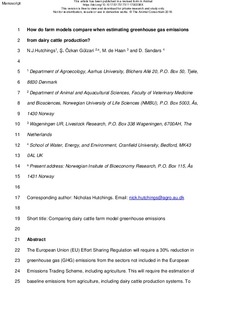| dc.contributor.author | Hutchings, Nick | |
| dc.contributor.author | Özkan_Gülzari, Seyda | |
| dc.contributor.author | De Haan, Michel | |
| dc.contributor.author | Sandars, Daniel L. | |
| dc.date.accessioned | 2018-05-31T08:00:21Z | |
| dc.date.available | 2018-05-31T08:00:21Z | |
| dc.date.created | 2017-12-07T08:45:22Z | |
| dc.date.issued | 2018-01-09 | |
| dc.identifier.citation | Hutchings, N., Özkan Gülzari, Ş, De Haan, M., & Sandars, D. (2018). How do farm models compare when estimating greenhouse gas emissions from dairy cattle production? Animal, 1-10 | nb_NO |
| dc.identifier.issn | 1751-7311 | |
| dc.identifier.uri | http://hdl.handle.net/11250/2499855 | |
| dc.description.abstract | The European Union Effort Sharing Regulation (ESR) will require a 30% reduction in greenhouse gas (GHG) emissions by 2030 compared with 2005 from the sectors not included in the European Emissions Trading Scheme, including agriculture. This will require the estimation of current and future emissions from agriculture, including dairy cattle production systems. Using a farm-scale model as part of a Tier 3 method for farm to national scales provides a more holistic and informative approach than IPCC (2006) Tier 2 but requires independent quality control. Comparing the results of using models to simulate a range of scenarios that explore an appropriate range of biophysical and management situations can support this process by providing a framework for placing model results in context. To assess the variation between models and the process of understanding differences, estimates of GHG emissions from four farm-scale models (DairyWise, FarmAC, HolosNor and SFARMMOD) were calculated for eight dairy farming scenarios within a factorial design consisting of two climates (cool/dry and warm/wet)×two soil types (sandy and clayey)×two feeding systems (grass only and grass/maize). The milk yield per cow, follower:cow ratio, manure management system, nitrogen (N) fertilisation and land area were standardised for all scenarios in order to associate the differences in the results with the model structure and function. Potential yield and application of available N in fertiliser and manure were specified separately for grass and maize. Significant differences between models were found in GHG emissions at the farm-scale and for most contributory sources, although there was no difference in the ranking of source magnitudes. The farm-scale GHG emissions, averaged over the four models, was 10.6 t carbon dioxide equivalents (CO2e)/ha per year, with a range of 1.9 t CO2e/ha per year. Even though key production characteristics were specified in the scenarios, there were still significant differences between models in the annual milk production per ha and the amounts of N fertiliser and concentrate feed imported. This was because the models differed in their description of biophysical responses and feedback mechanisms, and in the extent to which management functions were internalised. We conclude that comparing the results of different farm-scale models when applied to a range of scenarios would build confidence in their use in achieving ESR targets, justifying further investment in the development of a wider range of scenarios and software tools. | nb_NO |
| dc.language.iso | eng | nb_NO |
| dc.publisher | Cambridge University Press | nb_NO |
| dc.subject | dairy cattle | nb_NO |
| dc.subject | farm-scale | nb_NO |
| dc.subject | model | nb_NO |
| dc.subject | greenhouse gas | nb_NO |
| dc.title | How do farm models compare when estimating greenhouse gas emissions from dairy cattle production? | nb_NO |
| dc.type | Journal article | nb_NO |
| dc.type | Peer reviewed | nb_NO |
| dc.description.version | acceptedVersion | nb_NO |
| dc.rights.holder | © The Animal Consortium 2018 | nb_NO |
| dc.source.pagenumber | 1-10 | nb_NO |
| dc.source.journal | Animal | nb_NO |
| dc.identifier.doi | 10.1017/S175173111700338X | |
| dc.identifier.cristin | 1523926 | |
| dc.relation.project | Norges forskningsråd: 222943 | nb_NO |
| dc.relation.project | EU/AIR3-CT94-1584, ECFARM project | nb_NO |
| dc.relation.project | Internasjonale institusjoner: BBSRC - BB/N00485X/1 and BB/K010301/1 projects | nb_NO |
| dc.relation.project | Internasjonale institusjoner: UK Min.of Agric. og Biol.Sci.Res.Council - SFARMMOD | nb_NO |
| dc.relation.project | EU/FACCEJPI - MACSUR | nb_NO |
| dc.relation.project | Internasjonale institusjoner: UK Govt. Agric & Rural Affairs, WA0801, MEASURES project | nb_NO |
| cristin.ispublished | true | |
| cristin.fulltext | postprint | |
| cristin.qualitycode | 1 | |
